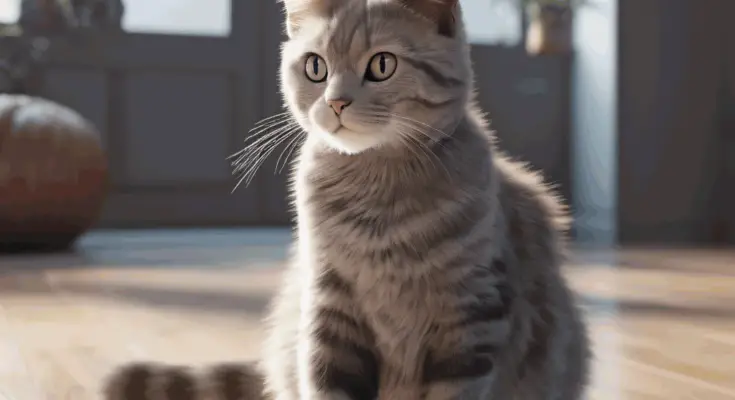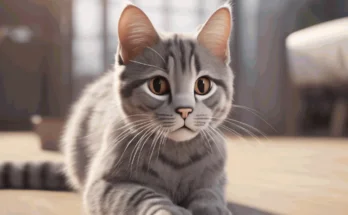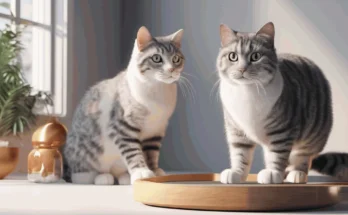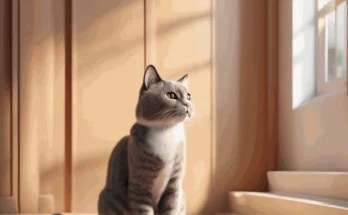As a cat owner, you may be under the impression that litter training is reserved exclusively for kittens. However, if you’ve recently welcomed an adult cat into your home, you might be surprised to learn that there’s a whole different process for adult cat litter training. If you ever asked yourself ‘how to litter train an adult cat’, then this article is for you
Remember, training an older cat to use a litter box may bring a unique set of challenges, but it’s far from impossible. You shouldn’t feel disheartened if your mature feline companion hasn’t yet adapted to using a litter box. In fact, with consistency, patience, and the use of proper methods, even older cat litter training can turn out to be a successful endeavor.
Key Takeaways
- Litter training isn’t exclusive to kittens, adult cats can also be trained.
- Throughout the adult cat litter training process, patience and consistency are key.
- The right method is crucial while training an older cat to use a litter box.
- Good litter box habits can be developed in adult cats with appropriate training.
- Addressing potential setbacks early on can smoothen the training process.
Understanding the Basics of Litter Training
When it comes to successfully training mature cats to use a litter box, understanding the feline instincts and behaviors is the key. Cats have natural inclinations for personal hygiene and privacy, which can be valuable when learning how to litter train an older cat.
Unlike dogs who rely on non-verbal cues and rewards, cats respond better to environmental modification. A key component of effective methods for litter training older cats is maintaining a clean and appealing litter space, as cats are innately clean animals who will seek out pleasant places to do their business.
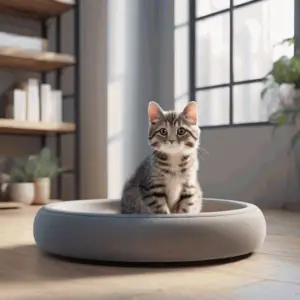
Understanding these essentials can go a long way in making the training process smoother and more effective.
Nevertheless, setting realistic expectations about the time frame and potential setbacks in litter training an adult cat is important. Bear in mind that older cats might take a longer time to adjust to new habits compared to kittens, and there will likely be a few hiccups along the way. But don’t worry – perseverance usually pays off.
Now, let’s shed some light on the basic elements involved in litter box training for older cats:
| Basic Element | Description |
| Litter Box | The primary tool for training should be large enough for the cat to move around comfortably. Covered or uncovered is a matter of feline preference. |
| Cat Litter | Options abound in terms of materials and textures, but it’s usually safest to go with unscented litter as cats tend to prefer simplicity and might be deterred by strong artificial scents. |
| Placement | A crucial aspect often overlooked, the litter box should be placed in a quiet, accessible area away from noise and high foot traffic to ensure the cat’s comfort and privacy. |
| Cleaning | Regular cleaning of the litter box ensures sanitary conditions and encourages continued box use by your cat. Neglected boxes might lead to inappropriate elimination. |
With these basics in mind and a patient, consistent approach, you’re well on your way toward effective litter training for your mature cat.
Litter Train an Adult Cat: Getting Started
Initiating litter training for an adult cat involves careful decision-making. The right litter box and litter, coupled with a friendly litter area, can set the stage for a successful training experience. Let’s delve into these constituent elements to kick-start your cat’s litter training process.
Choosing the Right Litter Box
Selecting a suitable litter container is a vital first step. It has to be huge and sufficient for the cat to show around without problems and coffee-sided to ensure a smooth right of entry, in particular for cats with mobility issues. Cats prefer privateness even as doing their enterprise, so a field with excessive facets and a removable cowl can be appealing.

Selecting the Best Litter for Adult Cats
The choice of clutter can substantially have an impact on your cat’s willingness to apply the clutter field. Considering the kind of litter to be had within the marketplace, you may need to experiment to find excellent clutter for personal cats. Cats typically choose fine-grained clutter because of its softness underneath their paws. Clumping litter is highly recommended due to its excellent odor control and ease of cleaning. Avoid scented varieties, which can deter some cats.
Setting Up the Litter Area
When you’re geared up to begin the litter container education, choose a quiet location where your cat can do their enterprise without disturbance. Also, make certain the muddle location is easily reachable always. This calm and inviting atmosphere can markedly boost your success with tips for training older cats to use the litter box.
| Element | Considerations |
| Litter Box | Size, Accessibility, Privacy |
| Litter | Texture, Clumping Ability, Odor Control, No Fragrance |
| Litter Area | Quietness, Accessible |
Transitioning Your Adult Cat to the Litter Box
Now that we have laid the groundwork, the real movement can begin. It’s time to inspire your older cat to apply their new litter container. This level needs gentle contact, but with endurance and perseverance, your feline buddy will have no hassle getting the grasp of it. Let’s take a more in-depth examine each step.
Introducing the Litter Box
When it comes to muddle container schooling, first impressions count the number. To keep away from overwhelming your cat, place them near the field and allow them to find out at their pace. You can enhance its appeal by sprinkling their favorite clutter or adding a catnip interior. Remember, it is all approximately developing a nice, pressure-free experience for your hairy pal.
Encouraging Use With Positive Reinforcement
Encouragement is key to any form of training, including for older cats learning to use a litter box. Whenever you see your cat using their box correctly, offer praise, affection, or even a small treat as a reward. This form of positive reinforcement helps cement the correct behavior and encourages repeated use.
Timing is everything – be sure to reward your cat immediately after they’ve used the litter box to clearly link the reward to the action.
Dealing With Avoidance Behavior
If your cat is avoiding the litter box, it’s important not to get discouraged. Understanding the root causes of this behavior and addressing them can help overcome the issue.
- Dirty litter box: Cats are clean animals and may refuse to use a dirty litter box. Ensure you clean the box regularly and thoroughly.
- Inappropriate location: If your cat feels exposed or unsafe while using the litter box, they may avoid it. Try placing the litter box in a quiet, low-traffic area.
- Health issues: Sometimes, avoidance behavior can be a sign of health problems. If your cat is persistently refusing to use the litter box despite all your efforts, consider making an appointment with your vet to rule out any medical issues.
As you can see, the transition stage may require both time and patience. But armed with these tips for training older cats to use a litter box, you are one step closer to success. Remember, every cat is unique, so personalized approaches and lots of love and patience are key to successful litter training.
| Issues | Solutions |
| Dirty litter box | Regular and thorough cleaning |
| Inappropriate location | Place in a quiet and low-traffic area |
| Health issues | Consult a vet |
Adult Cat Litter Box Training: Overcoming Challenges
While training your cherished feline friend, you might encounter several obstacles. These challenges can include ingrained habits, territorial issues, and health concerns. Implementing effective methods for litter training older cats can assist in overcoming these hurdles.
- Previous habits: An adult cat might have formed existing habits. Changing their routine might require extra patience and compassion.
- Territorial issues: Cats are naturally territorial animals. They might see the introduction of a litter box as a threat to their space.
- Health issues: Certain health problems can hamper your feline’s use of the litter box. Speak with a veterinarian to rule out any medical concerns.
Overcoming these challenges in adult cat litter box training demands an understanding of your feline’s behaviors and patience. Here are some tips:
- Patience is key: It might take your adult cat a little more time to get used to the new routine. Having patience during this process can achieve better results.
- Consistency: Ensuring a consistent routine is another crucial aspect of litter training. Stick with one type of litter and keep the box in the same location. A consistent routine helps your cat associate the box with its bathroom needs.
- Positive reinforcement: Reward your cat whenever it uses the litter box correctly. This can include vocal praise, petting, or treats.
Remember, every cat is unique and may require an extraordinary technique. The journey to a successful muddle schooling is not constantly straightforward, however with patience and information, it’s miles entirely possible. It’s critical to address any setbacks with kindness and resolution, making the education method a worthwhile enjoyment for each of you and your cat.
Maintaining Good Litter Box Habits
Once your mature feline companion has embraced the use of a litter box. The priority shifts to ensuring the habit’s longevity. Any training’s efficacy is measured by its consistent application and, in this case, maintaining good litter box habits. This continuity is influenced by a triad of factors; the cleanliness of the litter box, its location, and ongoing observance of regular usage.
Cleaning and Maintenance Tips
Maintaining sanitation in the litter box not only promotes hygienic conditions for your home but more importantly, supports your cat’s affinity for a clean elimination area. Regular removal of excrement, occasional litter replacement, and thorough cleansing of the box will ensure a fresh environment that protects against any potential aversions. Also, your choice of litter type plays a vital role; some cats favor unscented over heavily perfumed varieties and vice versa.
Location and Privacy Considerations
In nature, cats prefer secluded spots for elimination, and mimicking this sense of privacy bolsters your cat’s comfort with the litter box. Placing the litter box in a quiet, unobtrusive location in your house. Away from noisy appliances, food, and water sources is essential. Some cats also prefer having multiple options, particularly in multilevel homes, considering having more than one box.
Monitoring for Consistent Use
Understanding that litter box usage is also a barometer for your cat’s health is crucial. Noticing any significant fluctuations in her regular routines. Any changes in the elimination’s texture, color, or smell can signal potential health issues. In such cases, prompt consultation with your vet can circumnavigate any escalating problems. Training is an enduring process, and monitoring for consistent use plays an indispensable role in that journey.
What kind of litter box should I get for an adult cat?
Size and design matter when choosing a litter box for an adult cat. It should be large enough for the cat to turn around comfortably inside. Some older cats prefer boxes with low sides for easy access, while others might appreciate the privacy of a covered box. The key is to ensure your cat feels comfortable and safe when using the litter box.
Which litter is the best for adult cats?
The choice of litter often comes down to your cat's preference. Typically, unscented clumping litter, which is easy for cats to dig and mask their waste in, tends to be a safe bet. However, if your cat shows resistance, you may need to experiment with different types like paper, silica, or plant-based litter until you find one your cat likes.
How do I make the litter box more appealing to my adult cat?
Positioning and cleanliness can make a significant impact on the attractiveness of the litter box. It should be placed in a quiet, low-traffic area where your cat won't be disturbed. Regular scooping and cleaning to eliminate odors can also encourage your cat to use the litter box.
What do I do if my adult cat refuses to use the litter box?
Cats refuse the litter box due to a variety of reasons - from medical problems, tension with other pets, location of the box, to the type of litter used. If your cat stops using the box, a visit to the vet could be a good first step to rule out any health concerns. Next, consider if there have been recent changes to the home environment causing the cat stress. If nothing else works, experimenting with different types of litter, box styles or location may be necessary.
How do I maintain good litter habits with my adult cat?
Regular cleaning of the litter box is crucial. Many cats will refuse a dirty box. You should scoop the box daily and perform a thorough clean weekly. Also, ensure that the litter box is always accessible to your cat and that it's placed in a quiet, secure spot.
